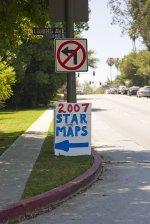MartinL
MartinL
This is my second post on this topic (1st was on the M8 forum). I'll start with a much stronger, more obvious, caveat here than that post: This is a matter of personal taste, judgement, and sense-making. I'm not trying to propose criteria for others, but I'd welcome responses, elaboration, disagreement.
I'm trying to solidify my 'developing' ideas on what distinguishes a street shot from all the other sorts of shots taken outdoors in urban environments (portraits, anything candid, architectural, anything in which the principal merit is mostly aesthetic such as pattern, texture, etc). The first thing that came to mind was that the photo (my photo--not yours🙂) should evoke a narrative or story that sets the image as a moment that has a past and future.
I'm offering the photo posted here as an example of how that "moment" need not be a coherent action, but how it can evoke an historical or sociological narrative. This was taken along Sunset Blvd, in L.A. I think it says a lot about my city and probably me
Thanks for listening.
Martin
I'm trying to solidify my 'developing' ideas on what distinguishes a street shot from all the other sorts of shots taken outdoors in urban environments (portraits, anything candid, architectural, anything in which the principal merit is mostly aesthetic such as pattern, texture, etc). The first thing that came to mind was that the photo (my photo--not yours🙂) should evoke a narrative or story that sets the image as a moment that has a past and future.
I'm offering the photo posted here as an example of how that "moment" need not be a coherent action, but how it can evoke an historical or sociological narrative. This was taken along Sunset Blvd, in L.A. I think it says a lot about my city and probably me
Thanks for listening.
Martin
Attachments
Last edited:


